stop start FIAT DOBLO COMBI 2015 2.G Owner's Manual
[x] Cancel search | Manufacturer: FIAT, Model Year: 2015, Model line: DOBLO COMBI, Model: FIAT DOBLO COMBI 2015 2.GPages: 323, PDF Size: 46.77 MB
Page 148 of 323
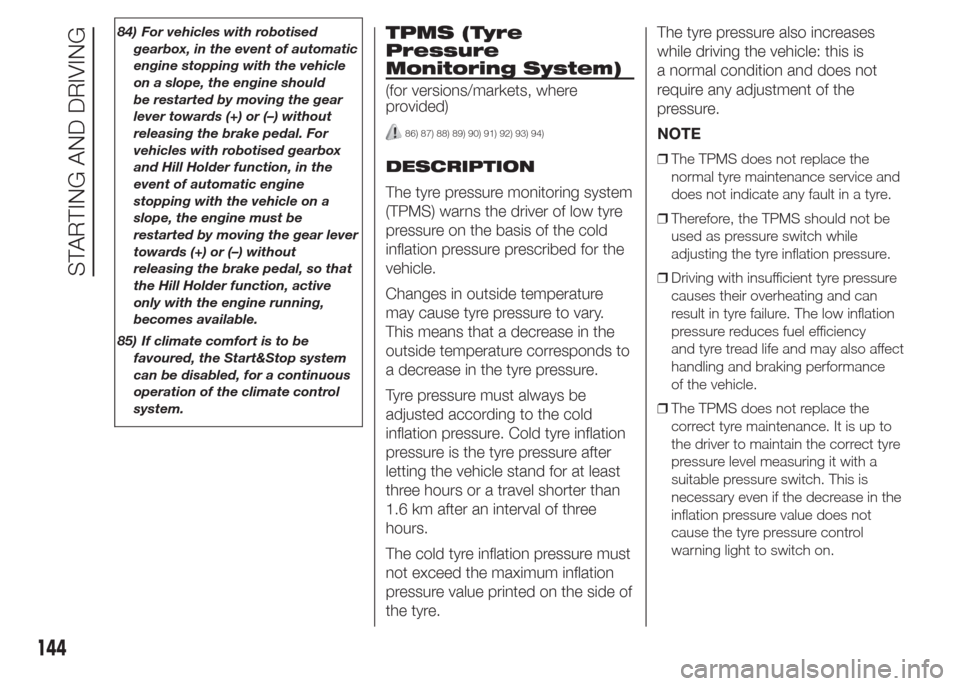
84) For vehicles with robotised
gearbox, in the event of automatic
engine stopping with the vehicle
on a slope, the engine should
be restarted by moving the gear
lever towards (+) or (–) without
releasing the brake pedal. For
vehicles with robotised gearbox
and Hill Holder function, in the
event of automatic engine
stopping with the vehicle on a
slope, the engine must be
restarted by moving the gear lever
towards (+) or (–) without
releasing the brake pedal, so that
the Hill Holder function, active
only with the engine running,
becomes available.
85) If climate comfort is to be
favoured, the Start&Stop system
can be disabled, for a continuous
operation of the climate control
system.TPMS (Tyre
Pressure
Monitoring System)
(for versions/markets, where
provided)
86) 87) 88) 89) 90) 91) 92) 93) 94)
DESCRIPTION
The tyre pressure monitoring system
(TPMS) warns the driver of low tyre
pressure on the basis of the cold
inflation pressure prescribed for the
vehicle.
Changes in outside temperature
may cause tyre pressure to vary.
This means that a decrease in the
outside temperature corresponds to
a decrease in the tyre pressure.
Tyre pressure must always be
adjusted according to the cold
inflation pressure. Cold tyre inflation
pressure is the tyre pressure after
letting the vehicle stand for at least
three hours or a travel shorter than
1.6 km after an interval of three
hours.
The cold tyre inflation pressure must
not exceed the maximum inflation
pressure value printed on the side of
the tyre.The tyre pressure also increases
while driving the vehicle: this is
a normal condition and does not
require any adjustment of the
pressure.
NOTE❒The TPMS does not replace the
normal tyre maintenance service and
does not indicate any fault in a tyre.
❒Therefore, the TPMS should not be
used as pressure switch while
adjusting the tyre inflation pressure.
❒Driving with insufficient tyre pressure
causes their overheating and can
result in tyre failure. The low inflation
pressure reduces fuel efficiency
and tyre tread life and may also affect
handling and braking performance
of the vehicle.
❒The TPMS does not replace the
correct tyre maintenance. It is up to
the driver to maintain the correct tyre
pressure level measuring it with a
suitable pressure switch. This is
necessary even if the decrease in the
inflation pressure value does not
cause the tyre pressure control
warning light to switch on.
144
STARTING AND DRIVING
Page 159 of 323
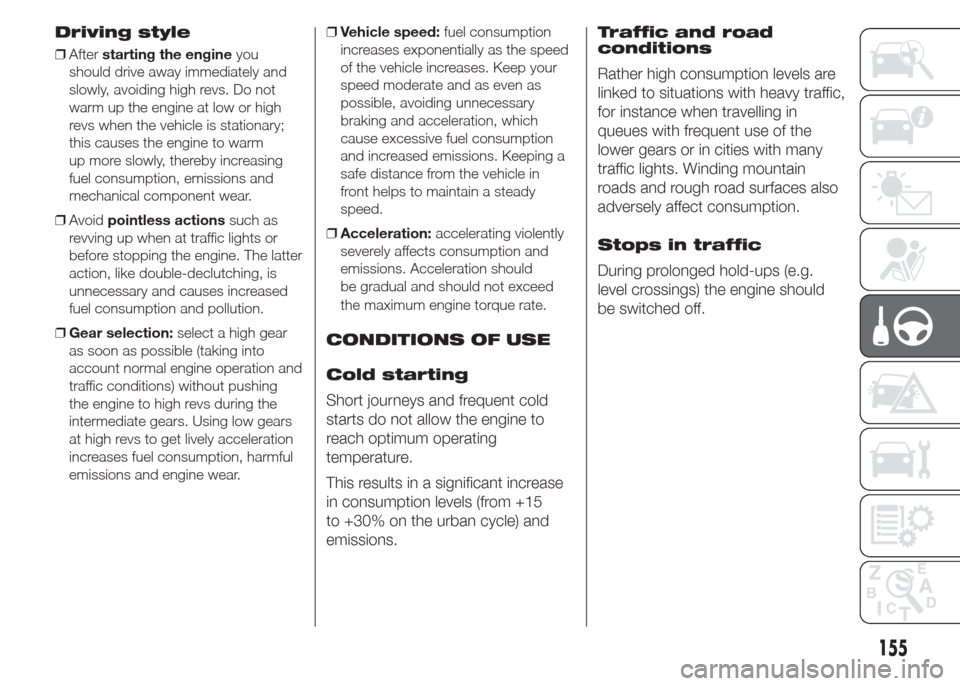
Driving style
❒Afterstarting the engineyou
should drive away immediately and
slowly, avoiding high revs. Do not
warm up the engine at low or high
revs when the vehicle is stationary;
this causes the engine to warm
up more slowly, thereby increasing
fuel consumption, emissions and
mechanical component wear.
❒Avoidpointless actionssuch as
revving up when at traffic lights or
before stopping the engine. The latter
action, like double-declutching, is
unnecessary and causes increased
fuel consumption and pollution.
❒Gear selection:select a high gear
as soon as possible (taking into
account normal engine operation and
traffic conditions) without pushing
the engine to high revs during the
intermediate gears. Using low gears
at high revs to get lively acceleration
increases fuel consumption, harmful
emissions and engine wear.❒Vehicle speed:fuel consumption
increases exponentially as the speed
of the vehicle increases. Keep your
speed moderate and as even as
possible, avoiding unnecessary
braking and acceleration, which
cause excessive fuel consumption
and increased emissions. Keeping a
safe distance from the vehicle in
front helps to maintain a steady
speed.
❒Acceleration:accelerating violently
severely affects consumption and
emissions. Acceleration should
be gradual and should not exceed
the maximum engine torque rate.
CONDITIONS OF USE
Cold starting
Short journeys and frequent cold
starts do not allow the engine to
reach optimum operating
temperature.
This results in a significant increase
in consumption levels (from +15
to +30% on the urban cycle) and
emissions.Traffic and road
conditions
Rather high consumption levels are
linked to situations with heavy traffic,
for instance when travelling in
queues with frequent use of the
lower gears or in cities with many
traffic lights. Winding mountain
roads and rough road surfaces also
adversely affect consumption.
Stops in traffic
During prolonged hold-ups (e.g.
level crossings) the engine should
be switched off.
155
Page 185 of 323
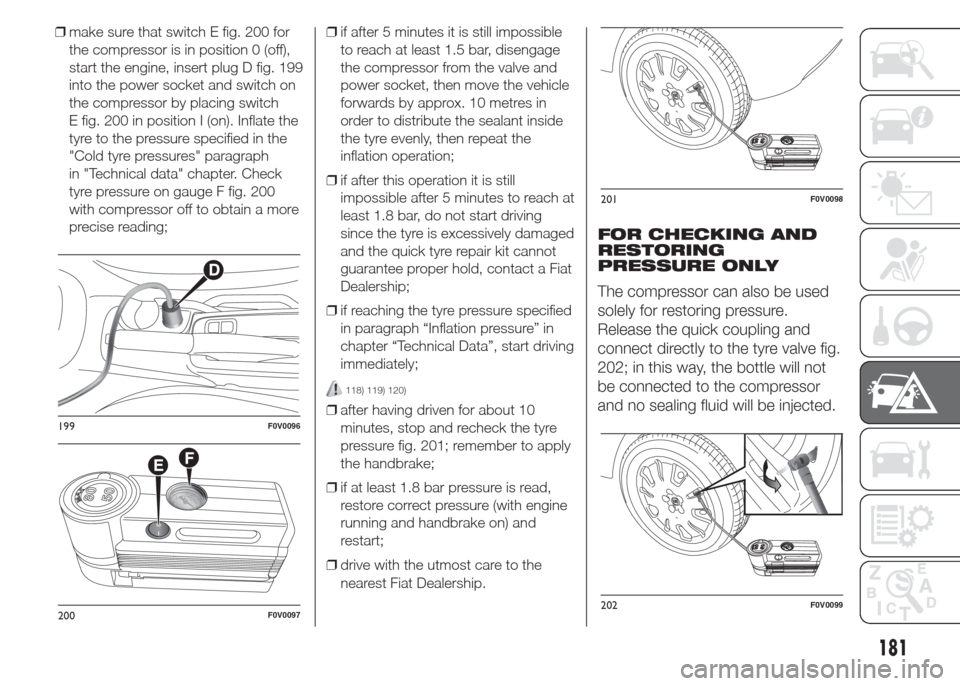
❒make sure that switch E fig. 200 for
the compressor is in position 0 (off),
start the engine, insert plug D fig. 199
into the power socket and switch on
the compressor by placing switch
E fig. 200 in position I (on). Inflate the
tyre to the pressure specified in the
"Cold tyre pressures" paragraph
in "Technical data" chapter. Check
tyre pressure on gauge F fig. 200
with compressor off to obtain a more
precise reading;❒if after 5 minutes it is still impossible
to reach at least 1.5 bar, disengage
the compressor from the valve and
power socket, then move the vehicle
forwards by approx. 10 metres in
order to distribute the sealant inside
the tyre evenly, then repeat the
inflation operation;
❒if after this operation it is still
impossible after 5 minutes to reach at
least 1.8 bar, do not start driving
since the tyre is excessively damaged
and the quick tyre repair kit cannot
guarantee proper hold, contact a Fiat
Dealership;
❒if reaching the tyre pressure specified
in paragraph “Inflation pressure” in
chapter “Technical Data”, start driving
immediately;
118) 119) 120)
❒after having driven for about 10
minutes, stop and recheck the tyre
pressure fig. 201; remember to apply
the handbrake;
❒if at least 1.8 bar pressure is read,
restore correct pressure (with engine
running and handbrake on) and
restart;
❒drive with the utmost care to the
nearest Fiat Dealership.
FOR CHECKING AND
RESTORING
PRESSURE ONLY
The compressor can also be used
solely for restoring pressure.
Release the quick coupling and
connect directly to the tyre valve fig.
202; in this way, the bottle will not
be connected to the compressor
and no sealing fluid will be injected.
199F0V0096
200F0V0097
201F0V0098
202F0V0099
181
Page 190 of 323
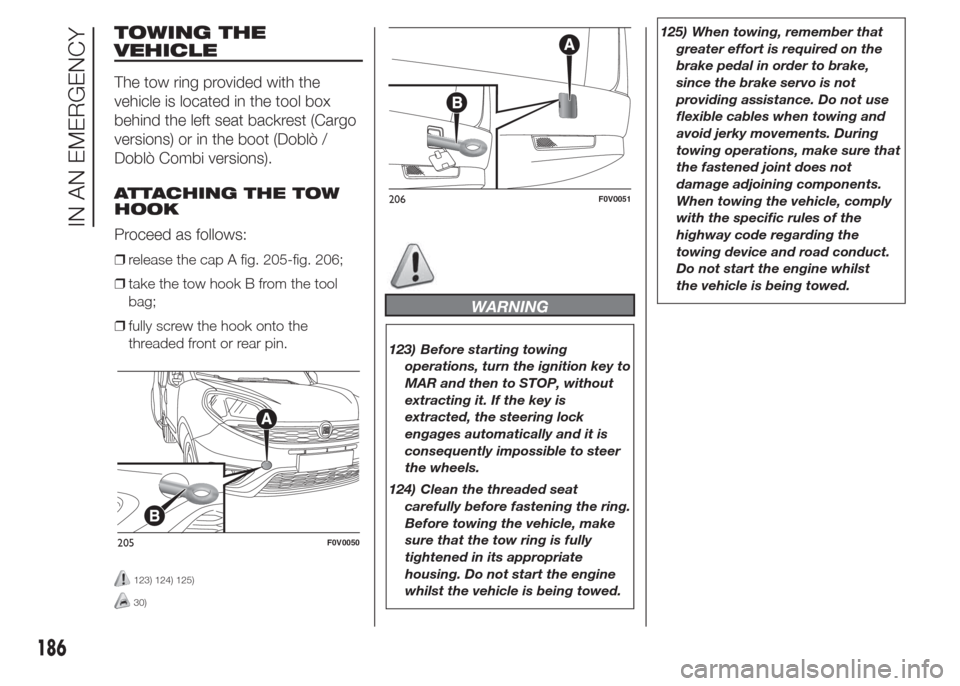
TOWING THE
VEHICLE
The tow ring provided with the
vehicle is located in the tool box
behind the left seat backrest (Cargo
versions) or in the boot (Doblò /
Doblò Combi versions).
ATTACHING THE TOW
HOOK
Proceed as follows:
❒release the cap A fig. 205-fig. 206;
❒take the tow hook B from the tool
bag;
❒fully screw the hook onto the
threaded front or rear pin.
123) 124) 125)
30)
WARNING
123) Before starting towing
operations, turn the ignition key to
MAR and then to STOP, without
extracting it. If the key is
extracted, the steering lock
engages automatically and it is
consequently impossible to steer
the wheels.
124) Clean the threaded seat
carefully before fastening the ring.
Before towing the vehicle, make
sure that the tow ring is fully
tightened in its appropriate
housing. Do not start the engine
whilst the vehicle is being towed.125) When towing, remember that
greater effort is required on the
brake pedal in order to brake,
since the brake servo is not
providing assistance. Do not use
flexible cables when towing and
avoid jerky movements. During
towing operations, make sure that
the fastened joint does not
damage adjoining components.
When towing the vehicle, comply
with the specific rules of the
highway code regarding the
towing device and road conduct.
Do not start the engine whilst
the vehicle is being towed.
205F0V0050
206F0V0051
186
IN AN EMERGENCY
Page 214 of 323
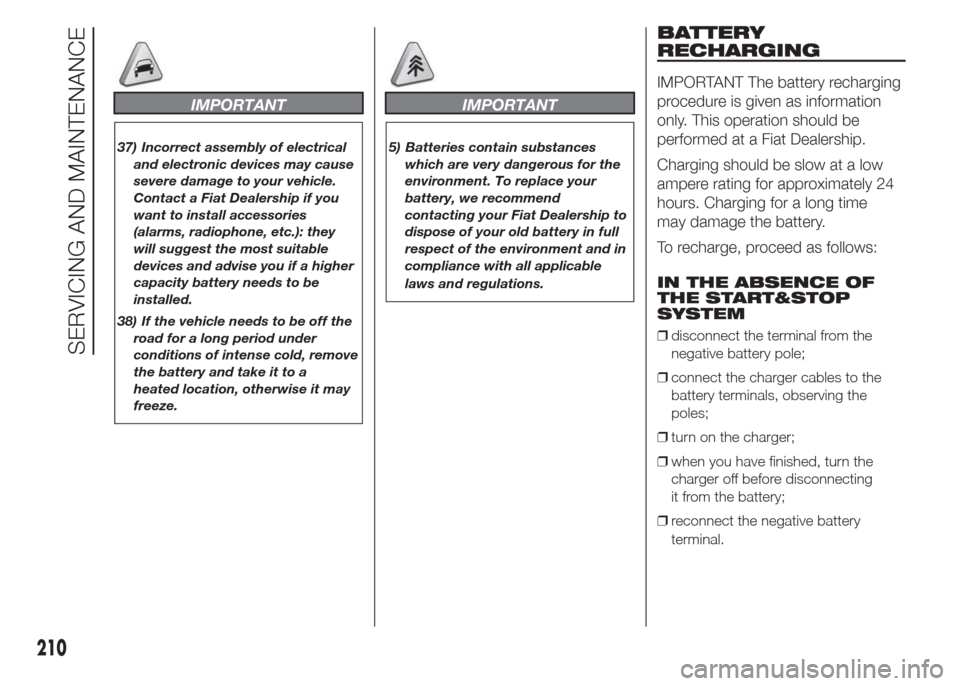
IMPORTANT
37) Incorrect assembly of electrical
and electronic devices may cause
severe damage to your vehicle.
Contact a Fiat Dealership if you
want to install accessories
(alarms, radiophone, etc.): they
will suggest the most suitable
devices and advise you if a higher
capacity battery needs to be
installed.
38) If the vehicle needs to be off the
road for a long period under
conditions of intense cold, remove
the battery and take it to a
heated location, otherwise it may
freeze.
IMPORTANT
5) Batteries contain substances
which are very dangerous for the
environment. To replace your
battery, we recommend
contacting your Fiat Dealership to
dispose of your old battery in full
respect of the environment and in
compliance with all applicable
laws and regulations.
BATTERY
RECHARGING
IMPORTANT The battery recharging
procedure is given as information
only. This operation should be
performed at a Fiat Dealership.
Charging should be slow at a low
ampere rating for approximately 24
hours. Charging for a long time
may damage the battery.
To recharge, proceed as follows:
IN THE ABSENCE OF
THE START&STOP
SYSTEM
❒disconnect the terminal from the
negative battery pole;
❒connect the charger cables to the
battery terminals, observing the
poles;
❒turn on the charger;
❒when you have finished, turn the
charger off before disconnecting
it from the battery;
❒reconnect the negative battery
terminal.
210
SERVICING AND MAINTENANCE
Page 215 of 323
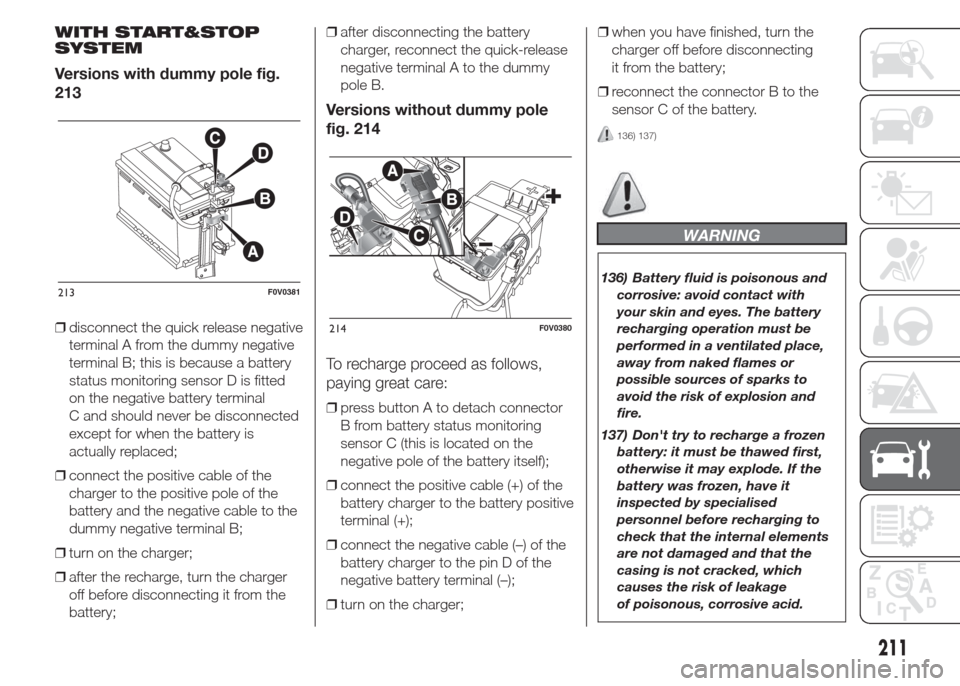
WITH START&STOP
SYSTEM
Versions with dummy pole fig.
213
❒disconnect the quick release negative
terminal A from the dummy negative
terminal B; this is because a battery
status monitoring sensor D is fitted
on the negative battery terminal
C and should never be disconnected
except for when the battery is
actually replaced;
❒connect the positive cable of the
charger to the positive pole of the
battery and the negative cable to the
dummy negative terminal B;
❒turn on the charger;
❒after the recharge, turn the charger
off before disconnecting it from the
battery;❒after disconnecting the battery
charger, reconnect the quick-release
negative terminal A to the dummy
pole B.
Versions without dummy pole
fig. 214
To recharge proceed as follows,
paying great care:
❒press button A to detach connector
B from battery status monitoring
sensor C (this is located on the
negative pole of the battery itself);
❒connect the positive cable (+) of the
battery charger to the battery positive
terminal (+);
❒connect the negative cable (–) of the
battery charger to the pin D of the
negative battery terminal (–);
❒turn on the charger;❒when you have finished, turn the
charger off before disconnecting
it from the battery;
❒reconnect the connector B to the
sensor C of the battery.
136) 137)
WARNING
136) Battery fluid is poisonous and
corrosive: avoid contact with
your skin and eyes. The battery
recharging operation must be
performed in a ventilated place,
away from naked flames or
possible sources of sparks to
avoid the risk of explosion and
fire.
137) Don't try to recharge a frozen
battery: it must be thawed first,
otherwise it may explode. If the
battery was frozen, have it
inspected by specialised
personnel before recharging to
check that the internal elements
are not damaged and that the
casing is not cracked, which
causes the risk of leakage
of poisonous, corrosive acid.213F0V0381
214F0V0380
211
Page 218 of 323
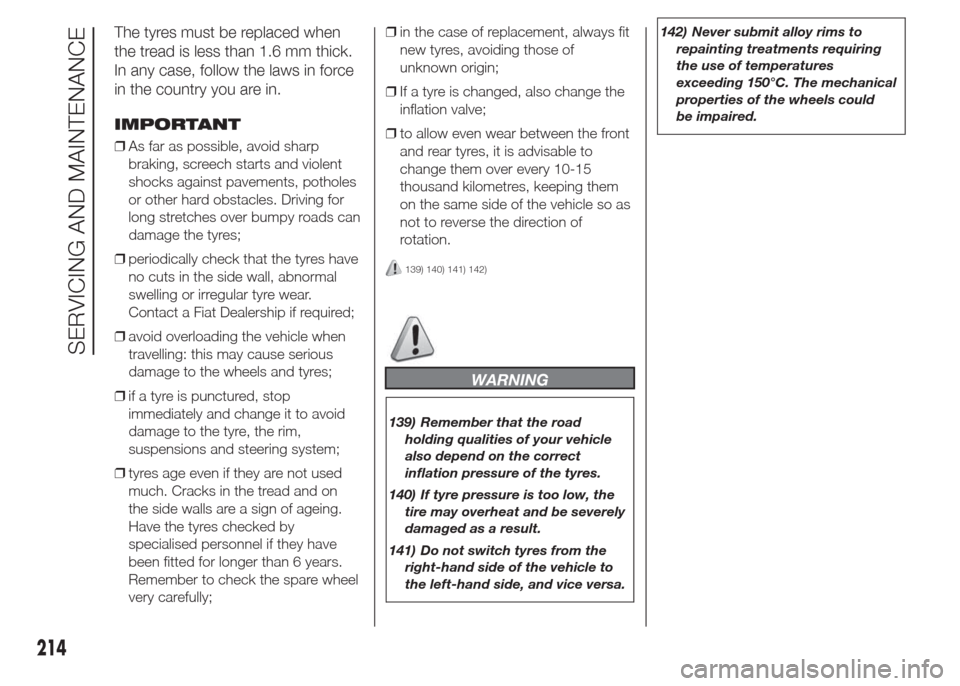
The tyres must be replaced when
the tread is less than 1.6 mm thick.
In any case, follow the laws in force
in the country you are in.
IMPORTANT
❒As far as possible, avoid sharp
braking, screech starts and violent
shocks against pavements, potholes
or other hard obstacles. Driving for
long stretches over bumpy roads can
damage the tyres;
❒periodically check that the tyres have
no cuts in the side wall, abnormal
swelling or irregular tyre wear.
Contact a Fiat Dealership if required;
❒avoid overloading the vehicle when
travelling: this may cause serious
damage to the wheels and tyres;
❒if a tyre is punctured, stop
immediately and change it to avoid
damage to the tyre, the rim,
suspensions and steering system;
❒tyres age even if they are not used
much. Cracks in the tread and on
the side walls are a sign of ageing.
Have the tyres checked by
specialised personnel if they have
been fitted for longer than 6 years.
Remember to check the spare wheel
very carefully;❒in the case of replacement, always fit
new tyres, avoiding those of
unknown origin;
❒If a tyre is changed, also change the
inflation valve;
❒to allow even wear between the front
and rear tyres, it is advisable to
change them over every 10-15
thousand kilometres, keeping them
on the same side of the vehicle so as
not to reverse the direction of
rotation.
139) 140) 141) 142)
WARNING
139) Remember that the road
holding qualities of your vehicle
also depend on the correct
inflation pressure of the tyres.
140) If tyre pressure is too low, the
tire may overheat and be severely
damaged as a result.
141) Do not switch tyres from the
righthand side of the vehicle to
the lefthand side, and vice versa.142) Never submit alloy rims to
repainting treatments requiring
the use of temperatures
exceeding 150°C. The mechanical
properties of the wheels could
be impaired.
214
SERVICING AND MAINTENANCE
Page 286 of 323
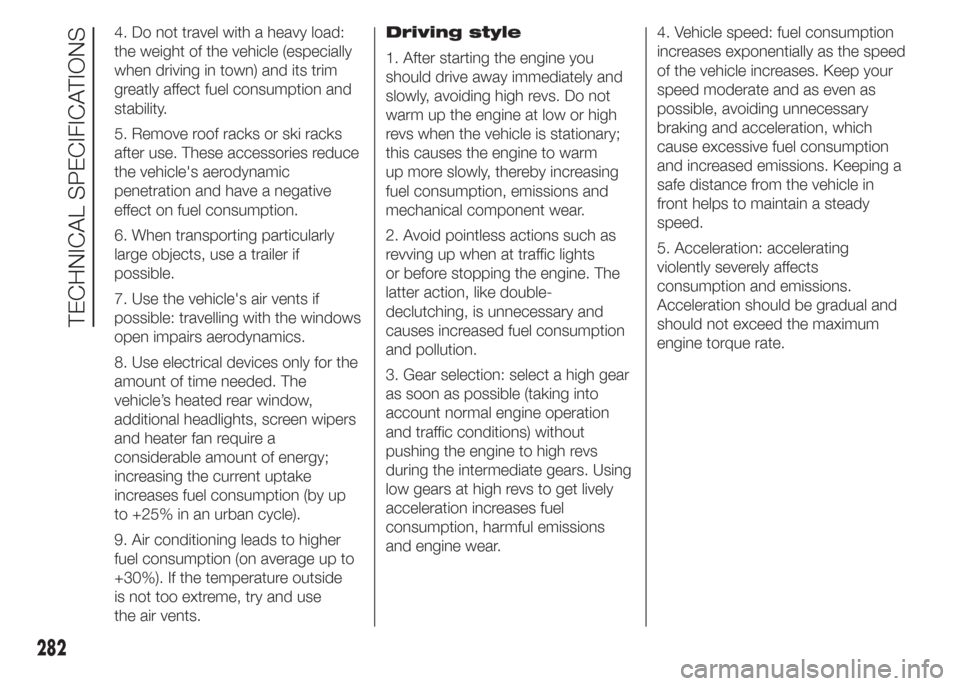
4. Do not travel with a heavy load:
the weight of the vehicle (especially
when driving in town) and its trim
greatly affect fuel consumption and
stability.
5. Remove roof racks or ski racks
after use. These accessories reduce
the vehicle's aerodynamic
penetration and have a negative
effect on fuel consumption.
6. When transporting particularly
large objects, use a trailer if
possible.
7. Use the vehicle's air vents if
possible: travelling with the windows
open impairs aerodynamics.
8. Use electrical devices only for the
amount of time needed. The
vehicle’s heated rear window,
additional headlights, screen wipers
and heater fan require a
considerable amount of energy;
increasing the current uptake
increases fuel consumption (by up
to +25% in an urban cycle).
9. Air conditioning leads to higher
fuel consumption (on average up to
+30%). If the temperature outside
is not too extreme, try and use
the air vents.Driving style
1. After starting the engine you
should drive away immediately and
slowly, avoiding high revs. Do not
warm up the engine at low or high
revs when the vehicle is stationary;
this causes the engine to warm
up more slowly, thereby increasing
fuel consumption, emissions and
mechanical component wear.
2. Avoid pointless actions such as
revving up when at traffic lights
or before stopping the engine. The
latter action, like double-
declutching, is unnecessary and
causes increased fuel consumption
and pollution.
3. Gear selection: select a high gear
as soon as possible (taking into
account normal engine operation
and traffic conditions) without
pushing the engine to high revs
during the intermediate gears. Using
low gears at high revs to get lively
acceleration increases fuel
consumption, harmful emissions
and engine wear.4. Vehicle speed: fuel consumption
increases exponentially as the speed
of the vehicle increases. Keep your
speed moderate and as even as
possible, avoiding unnecessary
braking and acceleration, which
cause excessive fuel consumption
and increased emissions. Keeping a
safe distance from the vehicle in
front helps to maintain a steady
speed.
5. Acceleration: accelerating
violently severely affects
consumption and emissions.
Acceleration should be gradual and
should not exceed the maximum
engine torque rate.
282
TECHNICAL SPECIFICATIONS
Page 287 of 323
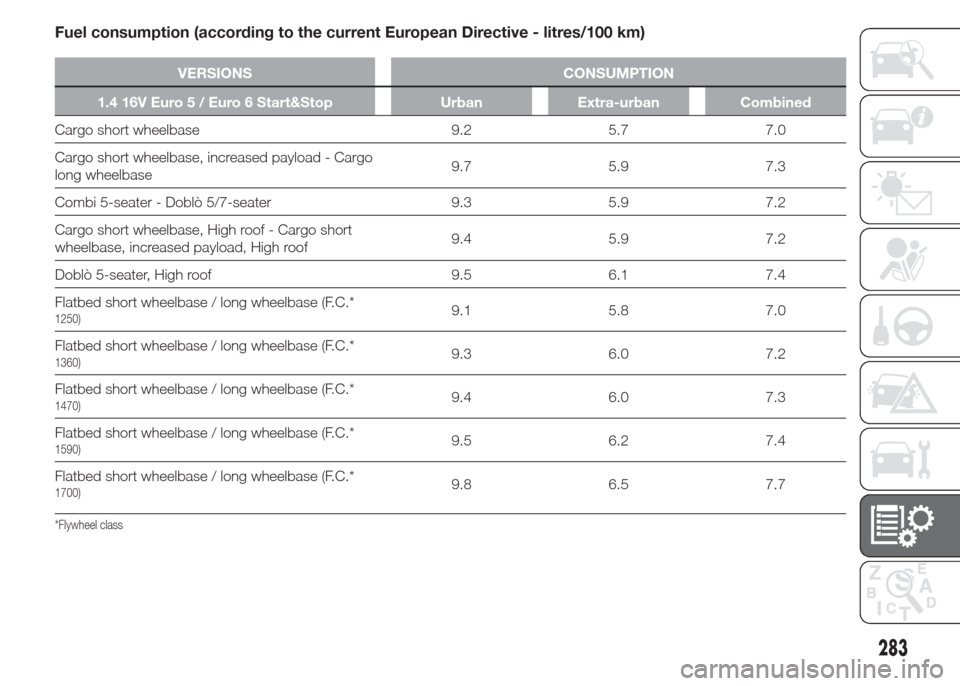
Fuel consumption (according to the current European Directive - litres/100 km)
VERSIONS CONSUMPTION
1.4 16V Euro 5 / Euro 6 Start&Stop Urban Extra-urban Combined
Cargo short wheelbase 9.2 5.7 7.0
Cargo short wheelbase, increased payload - Cargo
long wheelbase9.7 5.9 7.3
Combi 5-seater - Doblò 5/7-seater 9.3 5.9 7.2
Cargo short wheelbase, High roof - Cargo short
wheelbase, increased payload, High roof9.4 5.9 7.2
Doblò 5-seater, High roof 9.5 6.1 7.4
Flatbed short wheelbase / long wheelbase (F.C.*
1250)9.1 5.8 7.0
Flatbed short wheelbase / long wheelbase (F.C.*
1360)9.3 6.0 7.2
Flatbed short wheelbase / long wheelbase (F.C.*
1470)9.4 6.0 7.3
Flatbed short wheelbase / long wheelbase (F.C.*
1590)9.5 6.2 7.4
Flatbed short wheelbase / long wheelbase (F.C.*
1700)9.8 6.5 7.7
*Flywheel class.
283
Page 288 of 323
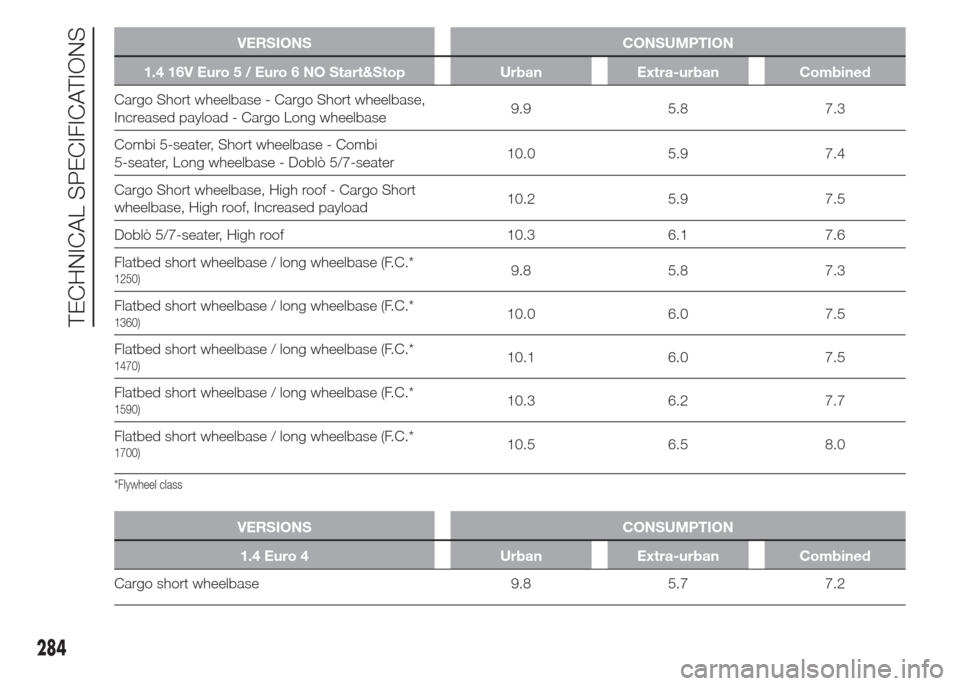
VERSIONS CONSUMPTION
1.4 16V Euro 5 / Euro 6 NO Start&Stop Urban Extra-urban Combined
Cargo Short wheelbase - Cargo Short wheelbase,
Increased payload - Cargo Long wheelbase9.9 5.8 7.3
Combi 5-seater, Short wheelbase - Combi
5-seater, Long wheelbase - Doblò 5/7-seater10.0 5.9 7.4
Cargo Short wheelbase, High roof - Cargo Short
wheelbase, High roof, Increased payload10.2 5.9 7.5
Doblò 5/7-seater, High roof 10.3 6.1 7.6
Flatbed short wheelbase / long wheelbase (F.C.*
1250)9.8 5.8 7.3
Flatbed short wheelbase / long wheelbase (F.C.*
1360)10.0 6.0 7.5
Flatbed short wheelbase / long wheelbase (F.C.*
1470)10.1 6.0 7.5
Flatbed short wheelbase / long wheelbase (F.C.*
1590)10.3 6.2 7.7
Flatbed short wheelbase / long wheelbase (F.C.*
1700)10.5 6.5 8.0
*Flywheel class.
VERSIONS CONSUMPTION
1.4 Euro 4 Urban Extra-urban Combined
Cargo short wheelbase 9.8 5.7 7.2
284
TECHNICAL SPECIFICATIONS